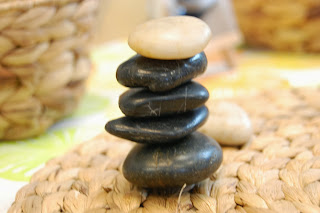Can you stack 5 rocks?
Mathematical Intention: one-to-one correspondence, counting, decomposing 5 into parts
What different patterns can you make?
Mathematical Intention: creating repeating patterns using 2-5 elements
What is a pattern?
Mathematical Intention: thinking about patterns in the environment, thinking about repeating, growing patterns, circular, framing patterns, grid patterns
What can you find out about numbers?
Mathematical Intention: one-to-one correspondence, counting, making ten, recognizing quantity arrangements, relate numerals to quantity, represent and describe numbers
How many ways can you make 7?
Mathematical Intention: parts-whole relationships, decomposing 7 into parts, one-to-one correspondence, counting, combining parts, adding
Things we noticed:
Students, for the most part, were fascinated with the simple materials and open-ness and stayed engaged for long periods of time.
We found leaving little clipboards with paper on the tables invited students to record and represent their work.
By adding a new element to a provocation, students became re-engaged and discovered new ways to work with the materials (ie. adding dice or calculators).
These table tasks create opportunities for teachers to spend time with individual students and talk to them about what they were doing, assessing their mathematical understanding as appropriate.























Nice job on setting up your math provocations. I like the ten frames that you have made out of popsicle sticks. I agree with you that the open ended materials sustain the children's attention for a good amount of time. Your pics have given me lots of ideas for my classroom. Thanks!
ReplyDeleteHEllo, where did you get the stacking rocks flascards? Many thanks!
ReplyDelete